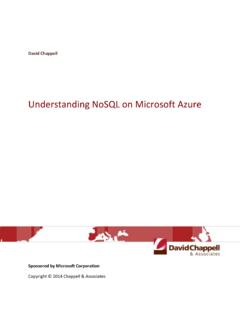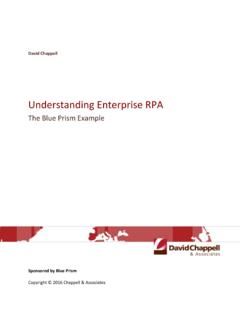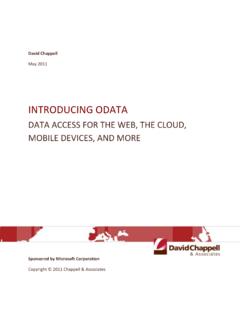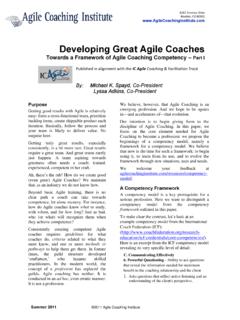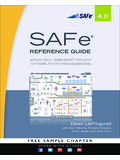Transcription of The Business Value of Agile Development - David …
1 David Chappell March 2012 THE Business Value OF Agile Development Sponsored by Microsoft Corporation Copyright 2012 Chappell & Associates 2 When it comes to creating custom applications, too many of us live in denial. We want to believe that it s possible to predict accurately how long a group of developers will take to build software that meets our requirements. We also want to believe that we can know what those requirements are up front, before we ve seen any part of the application, and that the requirements won t change during Development . Sadly, none of these things are true for most projects. We can t predict how long Development will take, largely because we can t get the requirements right up front and we can t stop them from changing. Because we deny these realities, many organizations still use software Development processes that don t work well.
2 Fortunately, this is changing. Agile Development processes get more popular every day, primarily because they re rooted in reality: They re designed to accommodate change. Doing software Development in this way can be scary at first, especially for the Business leaders who are footing the bill. This needn t be the case, however. The truth is that Agile processes are usually better both for Development teams and for the Business people who pay them. To understand why this is true, we need to start by understanding what an Agile process really is. What Agile Development Means The challenge is always the same: We need to create software in the face of uncertainty. At the start of a Development project, we don t know whether we ve defined the project s requirements correctly. We also don t know how those requirements will change while we re building the software.
3 A traditional Development process does its best to pretend this uncertainty doesn t exist. In the classic waterfall approach, for example, an organization creates detailed plans and precise schedules before writing any code. But real Development projects rarely comply with these plans and schedules they re notoriously unruly. The core reason for this is that even though we use the term software engineering , writing code isn t like other kinds of engineering. In traditional engineering projects building a bridge, say, or constructing a factory it s usually possible to define stable requirements up front. Once you ve done this, creating plans and schedules based on previous experience is straightforward. Software Development just isn t like this1. Creating stable requirements up front is usually impossible, in part because people don t know what they want until they see it.
4 And since every Development project involves some innovation if it doesn t, you should be buying rather than building the software uncertainty is unavoidable. Traditional Development processes work against these realities. Agile processes, however, are designed for this situation. Because requirements change, an Agile process provides a way to add, remove, and modify requirements during the Development process. Rather than resisting change, an Agile process embraces it. Just as important, the process recognizes that short-term plans are more stable than long-term plans. You might not know exactly what you want to be doing three months from now, but you probably do know what you want to do in the next three weeks. To accomplish this, an Agile Development process relies on iteration. Rather than the traditional approach of defining all of the requirements, writing all of the code, then testing that code, an Agile process does these things 1 In fact, maybe we should stop talking about software engineering it s a misleading term.
5 Rather than resisting change, an Agile process embraces it. 3 over and over in smaller iterations. Each iteration creates more of the finished product, with the requirements updated at the start of each one. Figure 1 illustrates this idea. Figure 1: An Agile Development process is iterative, with the ability to add, remove, or modify the project s requirements at the beginning of each iteration. The core idea is simple: Because requirements can be reassessed at the start of each iteration, an Agile process accommodates change. And since change is all but certain to happen in software Development projects, this is a very good thing. An Example Agile Process: Scrum Many Agile processes exist today, but the most popular is almost certainly Scrum. Scrum is simple to understand, and it provides a concrete illustration of how Agile Development works.
6 A key idea in Scrum is the notion of a product owner. The product owner represents the sponsor of the project, such as the Business group that s paying for this Development effort. The product owner doesn t need to understand code it s not a technical role but he or she does need to have a clear sense of what the software needs to do. Figure 2 summarizes the basics of Scrum from the perspective of the product owner and the Business sponsor this owner represents. 4 Figure 2: Each Scrum iteration includes the steps shown here. Like Agile processes in general, Scrum is iterative: Figure 2 shows a single iteration. From the perspective of a Business sponsor, the iteration has four steps: First, the product owner creates and prioritizes a list of items to be done (step 1). This list is called the product backlog, and it contains all of the requirements for the product.
7 It s a dynamic thing; what s on the list will change with each iteration. Next, based on priorities defined by the product owner, the Development team and the product owner select items from the product backlog for the sprint backlog (step 2). These items will be implemented by the Development team during this sprint, which commonly lasts two to four weeks. The Development team now implements the selected items (step 3). How they do this is entirely their responsibility; Scrum Development teams are self-organizing. The result of the sprint is potentially shippable software. In other words, it s a usable and tested implementation of the items in the sprint backlog. Once the sprint is over, the Development team demonstrates the implementation to the product owner (step 4). By getting concrete, hands-on experience with the software, the product owner can understand what s actually being created.
8 He or she then gives feedback, including suggestions for new or changed features that become part of the product backlog for the next iteration. By the time this iteration completes, requirements might have been added, removed, or modified. Whatever has changed, the product owner re-prioritizes the product backlog and the next iteration continues. This process continues until one of three things happens: The project runs out of money, the time allocated for the project expires, or all of the items on the product backlog are implemented. Notice how different this is from a traditional Development process. Agile Development still needs a plan, but the plan is only detailed on an iteration-by-iteration basis. In fact, lower priority items in the product backlog are 5 intentionally left loosely defined; things might change by the time they re implemented.
9 Progress isn t defined by adherence to a pre-defined plan. Instead, it s measured by the amount of usable software created. The Business Benefits of Agile Development Developers like Agile Development for various reasons, not least because it gives them more autonomy in how they do their job. But organizations should adopt Agile processes because of the Business benefits they bring, not just because they make developers happier. Those benefits are very real, and they include the following: The Development team is more likely to create what the Business really needs. The product owner who represents the Business , remember is directly responsible for creating and prioritizing the items in the product backlog. The Development team builds the most important things first, and so the sponsoring Business group is much more likely to get what it most wants, even if resource constraints don t let it get everything it would like.
10 And because the process is iterative, there are many chances to make changes, even near the end of the project. The product owner has a much better understanding of what s being created during the project. He or she has direct visibility into the project at every iteration, with the ability to change what happens in the next one. And nothing beats seeing and using early versions of software, which is by far the best way to understand what the software s users really want. The risk of a failed project is reduced. Agile s iterative approach lets you measure the right thing, which is whether you re getting the software you want. In a traditional process, you can only measure whether the project matches the plan, which isn t what you really care about. Without an Agile process, you don t know whether you ve gotten the right software until the project is over, when it s too late to do anything about it.
